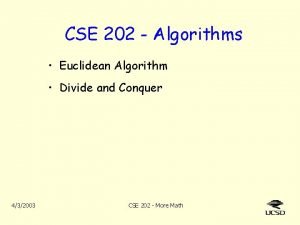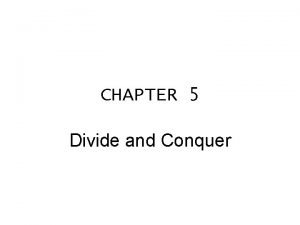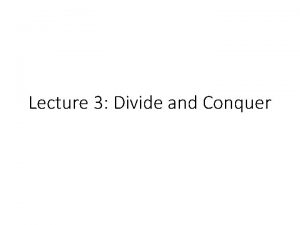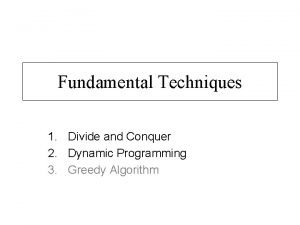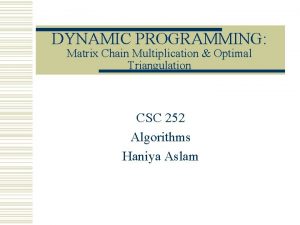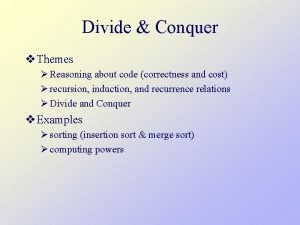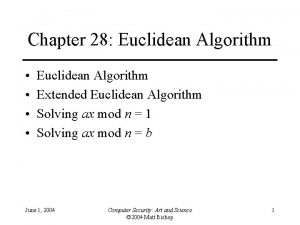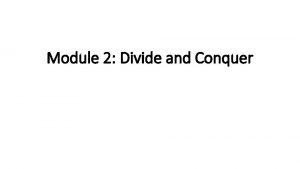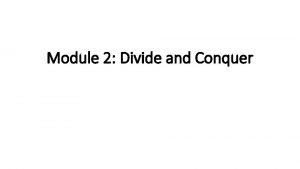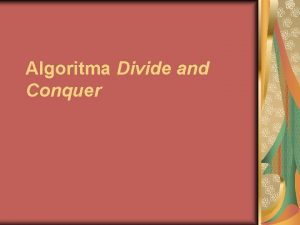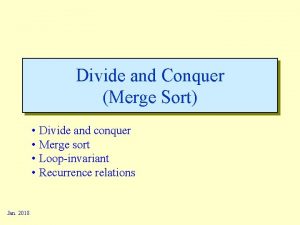CSE 202 Algorithms Euclidean Algorithm Divide and Conquer













- Slides: 13

CSE 202 - Algorithms • Euclidean Algorithm • Divide and Conquer 4/3/2003 CSE 202 - More Math

Euclidean Algorithm GCD stands for “greatest common divisor”. E. g. GCD(10, 25) = 5. If GCD(A, B)=1, we say A and B are relatively prime. Note that GCD(N, 0) = N. (At least for N>0. ) Thm: If A + k. B = C and B 0, then GCD(A, B) = GCD(B, C). Proof. Let g = GCD(A, B) and h = GCD(B, C). Since g divides A and B, it must divide A + k. B = C. Since g is a common divisor of B and C, it must be their greatest common divisor, i. e. g h. Reversing the roles of A and C, we conclude that h g. Thus, g = h. QED The Euclidean Algorithm finds GCD(A, B). Given A > B > 0, set C = A mod B (so C = A - k. B for some k and C<B). 2 This reduces the problem of finding GCD(A, B) to the smaller problem, finding GCD(B, C). Eventually, we’ll get to GCD(X, 0) = X. CSE 202 - More Math

Euclidean Algorithm Example: Find GCD of 38 and 10. 38 mod 10 = 8 10 mod 8 = 2 8 mod 2 = 0 GCD(2, 0) = 2 3 CSE 202 - More Math

Ext end ed Euclidean Algorithm Example: Find GCD of 38 and 10. 38 mod 10 = 8 10 mod 8 = 2 8 mod 2 = 0 GCD(2, 0) = 2 Lets you write 8 in terms of 38 and 10 Lets you write 2 in terms of 10 and 8. Change 8’s to 10’s and 38’s Voila! 8 = 38 - 3 x 10 2 = 10 – 1 x 8 = 10 – 1 x(38– 3 x 10) 2 = 4 x 10 – 1 x 38 Can write “ 2” as linear combination of 10 and 38. 4 CSE 202 - More Math

Euclidean Magic Linear equations over integers • Solve Diophantine Equations: – E. g. “ a x 38 + b x 10 = 6” • First write GCD(38, 10) using 10 & 38 (2 = 4 x 10 – 1 x 38), then multiply by 6/GCD = 3 (6 = 12 x 10 – 3 x 38). • Rational approximations: – E. g. 31416 = 3 x 10000 + 1416 10000 = 7 x 1416 + 88 – Let’s pretend 88 0. We then have 1416 10000/7 Thus, 31416 3 x 10000 + 10000/7 = 10000 x(3+1/7) Thus, 3. 1416 3+1/7 = 22/7 (= 3. 142857. . . ) We can get all “close” approximations this way. 5 CSE 202 - More Math

Morals • Once you have solved something (e. g. GCD), see if you can solve other problems (e. g. linear integer equations, approximations, . . . ) • I’ve shown some key ideas without writing out the algorithms – they are actually simple. “Continued fractions” does this all nicely! • If this is your idea of fun, try cryptography. 6 CSE 202 - More Math

Divide & Conquer • Basic Idea – Break big problem into subproblems – Solve each subproblem • Directly if it’s very small • Otherwise recursively break it up, etc. – Combine these solutions to solve big problem 7 CSE 202 - More Math

Faster Multiplication ? ? Standard method for multiplying long numbers: (1000 a+b)x(1000 c+d) = 1, 000 ac + 1000 (ad + bc) + bd 4 multiplies: ac, ad, bc, bd 3 multiplies: Clever trick: ac, (a+b)(c+d), bd (1000 a+b)x(1000 c+d) = 1, 000 ac + 1000 ( (a+b)(c+d) – ac - bd) + bd One length-k multiply = 3 length-k/2 multiplies and a bunch of additions and shifting. On computer, might use 216 in place of 1000 Fine print: If “a+b” has 17 bits, drop the top bit, but add extra c+d in the right place. Handle overflow for c+d similarly. 8 CSE 202 - More Math

Faster Multiplication !! To magnify savings, use recursion (Divide & Conquer). Let T(n) = time to multiply two n-chunk numbers. For n even, we have T(n) < 3 T(n/2) + c n This is called a recurrence equation Make c big enough so that cn time lets you do all the adds, subtracts, shifts, handling carry bits, and dealing with +/-. Reasonable, since operations are on n-chunk numbers. Recursively divide until we have 1 -chunk numbers Need lg n “divide” steps. Also make c big enough so T(1) < c. 9 CSE 202 - More Math

Recursion Tree cn c n/2 c n/4 c n/4 . . . c . . . 10 c c 1 depth-0 node 3 depth-1 nodes c n/2 . . . c n/4 c 9 depth-2 nodes . . . c 3 lg n depth-lg n nodes c CSE 202 - More Math

From the picture, we know. . . T(n) < cn ( 1 + 3(1/2) + 9(1/4) +. . . + 3 lg n(1/ 2 lg n) ) < cn ( 1 + 3/2 + (3/2)2 +. . . + (3/2)lg n ). Lemma 1: For a 1, ak + ak-1 +. . . 1 = (ak+1 – 1) / (a-1) Proof: (ak + ak-1 +. . . 1) (a-1) = ak+1 - 1 It’s obvious! (Multiply it out – middle terms cancel. ) By lemma 1, T(n) < cn ( (3/2)(lg n + 1) – 1) / ((3/2)-1) < cn ( (3/2)lg n (3/2) – 0) / (1/2) = c n (3/2) lg n (3/2)/(1/2) = 3 c n (3/2) lg n. 11 CSE 202 - More Math

And finally. . . Lemma 2: a lg b =b lg a Proof: alg b = (2 lg a)lg b = 2 lg a lg b = (2 lg b)lg a = blg a Applying Lemma 2, we have T(n) < 3 cn (3/2)lg n = 3 cn (nlg(3/2)) = 3 c n 1+lg(3/2). Thus, T(n) O(n 1+lg(3/2)) = O(nlg 3) =O ( n 1. 58. . . ). 12 CSE 202 - More Math

Key points • Divide & Conquer can magnify a small advantage. • Recursion tree gives a method of solving recurrence equations. – We’ll look at other methods next. • Lemmas 1 and 2 are useful. – Make sure you’re comfortable with the math. 13 CSE 202 - More Math
 Cse 202
Cse 202 Delaunay triangulation divide and conquer algorithm
Delaunay triangulation divide and conquer algorithm Delaunay triangulation divide and conquer algorithm
Delaunay triangulation divide and conquer algorithm Tiling problem using divide and conquer algorithm
Tiling problem using divide and conquer algorithm Divide and conquer and greedy method
Divide and conquer and greedy method Divide and conquer algorithm
Divide and conquer algorithm Skyline problem divide and conquer java
Skyline problem divide and conquer java Divide and conquer advantages and disadvantages
Divide and conquer advantages and disadvantages Counting inversions divide and conquer
Counting inversions divide and conquer Metoda divide et impera c++ probleme rezolvate
Metoda divide et impera c++ probleme rezolvate Divide and conquer
Divide and conquer Dynamic programming vs divide and conquer
Dynamic programming vs divide and conquer Prove correctness of divide and conquer
Prove correctness of divide and conquer How to divide in pseudocode
How to divide in pseudocode
